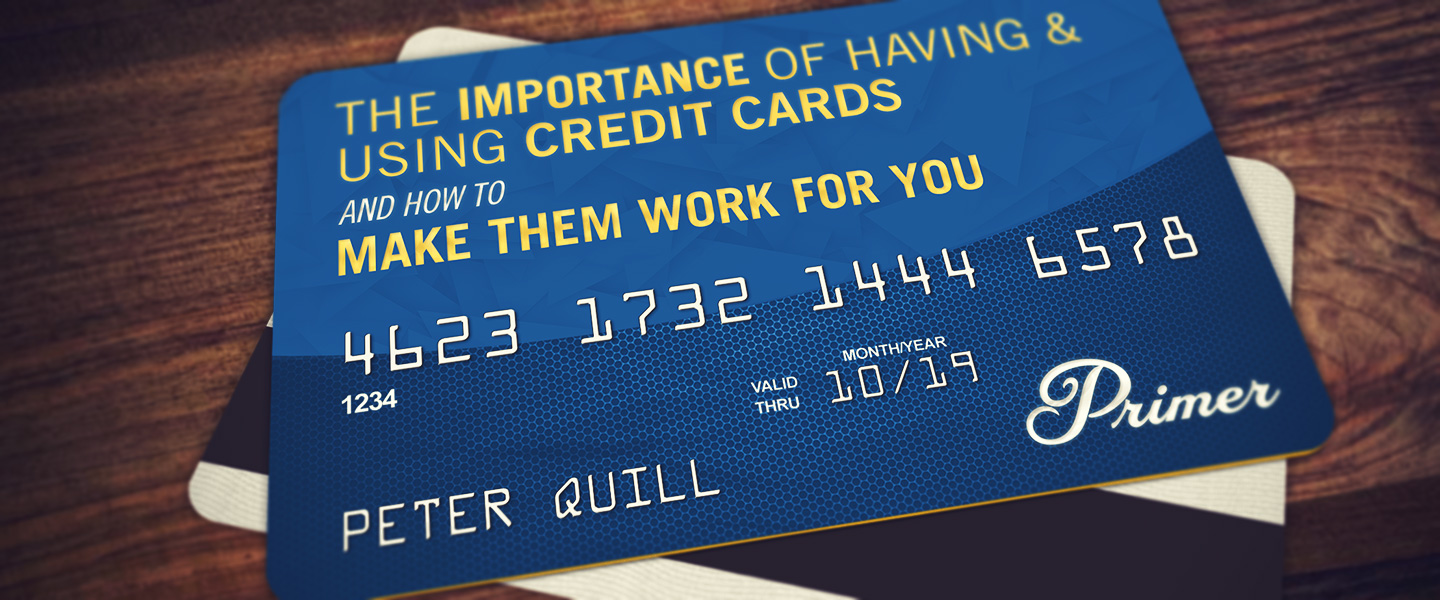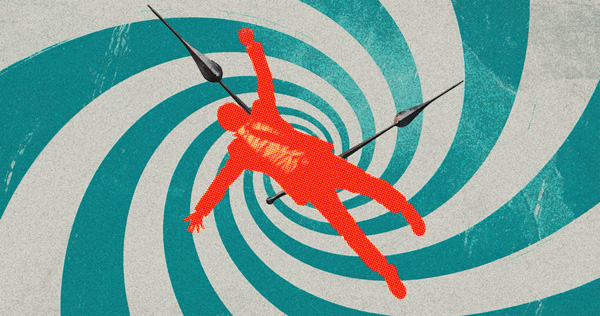One word: Plastic. Like it or not, we live in a world where credit is king. Almost nobody buys a house or a new car in cash, so sooner or later you’re going to have to use credit to obtain the things you want in life.
According to a 2013 analysis by Statistic Brain, American college students have an average of $3,173 in credit card debt. Which is a spit in the bucket compared to the average credit card debt per American household, a whopping $15,799.
Young people who came of age during the Great Recession are more reluctant than previous generations to take on mountains of credit card debt, and that’s a good thing. But eschewing credit altogether is just not practical.
Credit opens the door to things like getting your own cell phone plan, home ownership, or getting a business loan, and having good credit can put you over the top in unexpected situations where your credit score can factor in, like applying for jobs or when vying with someone else for an apartment you love.
“A lot of 20-somethings these days are shying away from credit cards and gravitating towards debit cards or pre-paid cards. That’s a pretty big mistake,” Credit Cards Director of NerdWallet.com Kevin Yuann said in a phone interview.
“I think the perception is if you use those you can’t spend what you don’t have. Which is true, so they’re a good product for people who don’t have the discipline of not racking up credit card debt, but those cards don’t build your credit score,” he said.
When you get your first credit card, usually in your early 20s, it’s a sort of fork in the road of your financial life. One path leads to a lifetime of playing catch-up with ever-increasing debt, the other to lower interest rates, rewards, and easier to obtain loans.
Would you loan money to someone you didn’t know? Or to someone you know has repeatedly failed to pay back money they borrowed? Not if you’re smart. And credit card companies are very smart. Cards issued to people new to the credit game typically come with higher than average interest rates and worse than average rewards (if any). This is because in their eyes you are an unknown quantity. As you show you can handle the responsibility, your creditworthiness will increase, and other lenders will see that you are someone who honors your debts. That’s the guy you want to be.
If you’re reading this, chances are you already have at least one credit card under your belt. That’s an important first step, according to Yuann.
“People should definitely get a credit card as early on as they can and use it responsibly. One of the most important factors in your credit score is average age of account. Which is hard, because you can only affect it by getting older,” Yuann said in a phone interview.
“You should find one that has no annual fee, because [your first credit card] is a card you typically never cancel. You may not be able to get the best rewards card, so you’re going to qualify for something that probably isn’t the card you’re going to be using as your primary card in three years, five years, ten years, but it is a card you’ll want to leave open your entire life, with maybe one recurring monthly bill hitting it,” he said.
Even if you carry over a balance month-to-month, which you shouldn’t, you may notice the minimum monthly payment to keep your account in good standing is quite low. Maybe as low as $25. Sounds great, right? Not if you do the math.
Let’s say you have a balance of $2,500 on a credit card with an interest rate of 23 percent. Using Bankrate.com’s credit card calculator, that would make your minimum monthly payment $72.92. Assuming you pay exactly that amount each month, that debt will take just under 18 years to pay off in full, during which time you will have paid $4,137.38 IN INTEREST ALONE. And don’t forget, if you miss even one payment, in addition to hitting you with a $35-or-so late payment penalty, the card company has the option to jack up your interest rate to the penalty rate of 29.9 percent APR, the highest rate allowed by law for credit cards. Ouch.
So how can you protect yourself?
“The first thing someone should do when they open a line of credit is to set up online payments, and make sure they make them. Your payment history is more than 30 percent of your credit score,” says Yuann.
Your credit score, or FICO score, is tabulated using five factors: Length of credit history, types of credit used, new credit, amounts owed and payment history. The last two alone make up 65 percent of your credit score. The amount of debt you owe on your credit cards compared to the total amount of credit you have available is called your “utilization,” and it’s a big factor in determining your creditworthiness. According to Credit Karma, the ideal range to keep up your credit score is 30 percent or less. For example, if you had $10,000 in total credit lines across your credit cards, you’d want to keep your balance no higher than $3,000 or risk a ding for utilization. Your utilization gradually improves on its own through good credit habits, as your credit lines magically tend to increase when you pay your bills on time and regularly, which automatically ups your available credit and lowers your utilization.
Reward Yourself…With Caution
Once you’ve built up your credit history and score, doors open to all kinds of benefits and perks. From free or discounted travel to points redeemable at stores to straight up cash back, credit card companies reward those who use their products responsibly. The kind of rewards program that is most attractive to you depends on your lifestyle and needs.
Are you a frequent traveler?
“An airline card makes sense if you live near a particular airline’s hub so you know you’ll fly them a lot,” Yuann says. “The ancillary benefits of it really make sense: free checked bags, early boarding, whatever the benefits are.”
For flexibility, Yuann suggests the Chase Sapphire Preferred card, which earns you travel rewards usable with a number of different carriers.
“You can also look at travel statement rewards cards like Capital One Venture or Barclay’s Arrival Plus, where you earn miles, but instead of redeeming them, you purchase a ticket with the card and they apply whatever you’ve accrued for rewards as a statement credit against that purchase. It doesn’t matter who you fly with, and sometimes doesn’t matter if it’s an airline ticket, hotel or rental car, it’s a statement credit against that travel expense.”
But what about for us earthbound folk?
“Cash back is the way to go, because there’s nothing better than cold hard cash,” says Yuann.
“You can save it, you can go buy whatever toy you fancy at the moment. There are two types of rewards cards: one for people who want to maximize their rewards, and one for people who want more simplicity in their life. People who want to maximize their rewards will look for cards with rotating categories that give you 5 percent back, but you have to be very conscientious of that. Those are cards like the Chase Freedom or Discover It.”
However, Yuann says, “If you’re someone who wants cash back but you don’t want to think about it, then you want a card that earns a flat rewards fee. The Capital One Quicksilver or the Citi Double Cash are two good examples.”
The prospect of stacking up those rewards is exciting, but the value of those perks evaporates and then some pretty fast if you carry a balance each month, so it’s important to stay grounded in that reality, no matter how sweet the rewards may look on paper.
“If we’re talking a rewards card that earns you 1-2 percent back in rewards, that’s going to be completely blown away by the APR if you do revolve that balance, because the average APR for a credit card is somewhere around 15-16 percent,” says Yuann.
Remember, credit cards wouldn’t give you rewards if it actually cost them money. So don’t think you can game the system and buy a ton of stuff and somehow end up with more money than you had when you started because of rewards. That isn’t gonna happen. Reward cards are only even worth it if you are not paying any interest, or if you pay your bill in full each month.
Much like asking for a raise from your employer for helping increase their bottom line, you shouldn’t be afraid to call up your credit cards to ask for a better rate if you feel you’ve earned it. Many card companies automatically re-evaluate your account every 6 months or so, but on more than one occasion I’ve been able to get a lower interest rate or a higher credit line by simply calling up and asking for it.
Juggling multiple credit card accounts at once can be tricky, so you want to avoid having more cards than you can keep track of. One smart method is to have specific cards for specific purposes, and setting them to automatically pay off in full each month.
“The average American has between 3-4 credit cards they use for different things. I have a credit card that’s my general spending card that’s a flat cash back card, I have an airline card I use because of the airline benefits I get with it, and I have another card I use with a specific retailer. As you graduate to a higher credit score you should start evaluating having several different credit lines,” says Yuann.
Finding the Right Balance
It’s a lot of information and a lot of responsibility. If you aren’t vigilant, things can spiral out of your control. Credit is a lot like fire in that respect: an incredibly helpful tool when used carefully, but extremely dangerous in the wrong hands or used improperly.
If you find yourself behind the eight ball with a high interest credit account, transferring your outstanding balance to a card with low or no interest could save you some money and buy you some time. It will typically cost around 3-5 percent of the amount transferred, but if you’re forking over big money each month for interest, looking into a balance transfer card like Chase Slate, which offers no real perks but can offer as much as 15 months with a promotional zero percent APR as a release valve is an option, but only if you have a plan for paying it off that you actually can stick to. Otherwise it can just compound the problem. Do the math—find out what it would cost you to do a balance transfer, and compare that to how much interest you pay each month and pick whichever option is cheapest. Just don’t let it become a habit.
“Transferring it once is fine if you have a plan of how you’re going to pay it off, that’s a smart thing to do. But if you’re constantly playing a game of shifting a balance from one card to another, it’s going to catch up with you,” says Yuann.
“Everyone makes mistakes, and there are products out there to help you work your way out of that debt without getting deeper into it,” he says.
If You Need to Buy It With Credit, Can You Actually Afford it?
I’m being quite literal here. That’s really the basis of what credit is. It’s very simple: you don’t have the cash to buy this item now, but you will sooner or later, or you can afford regular payments on a card with 0% interest. Psychologically it makes it a lot easier to buy something pricey if you don’t have to pay until later, as “later” is an abstract concept. Especially if you’re at the store standing in front of a shiny new flat screen. But later always comes knocking. And a surefire way to get burned by later’s inevitable visit is to get sucked into making a big purchase on a new card with a zero percent promotional interest rate.
When it expires and you haven’t paid off the amount, suddenly that “free money” isn’t so free anymore. And that flat screen could end up costing you a whole lot more than it says on the price tag. Make sure to read in your credit agreement for any new card what the APR will be once the introductory rate expires. If you have to, call the company directly and ask the exact date the promo rate expires, then make it your goal to have the card zeroed out by that date.
So just like anything else in the world of grown-up finance, a little responsibility and a lot of self-control go a long way. If you keep your wits about you, always pay your bills on time and minimize frivolous credit purchases, instead of working to pay off your debt, you can let credit work for you and reap some pretty sweet rewards in the process.
















